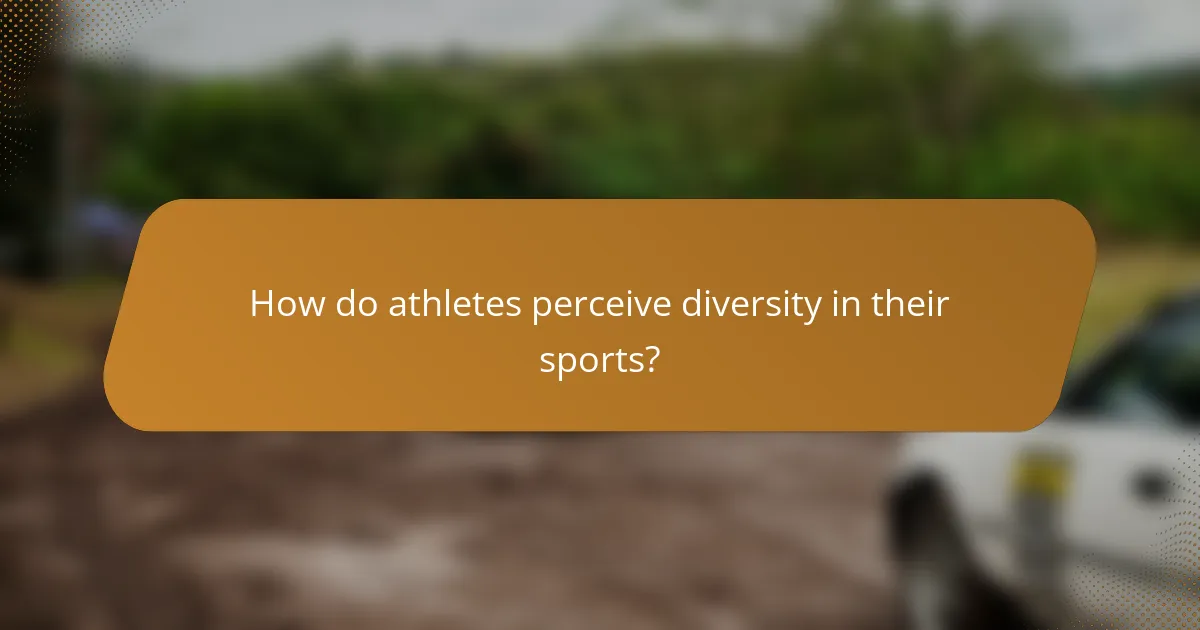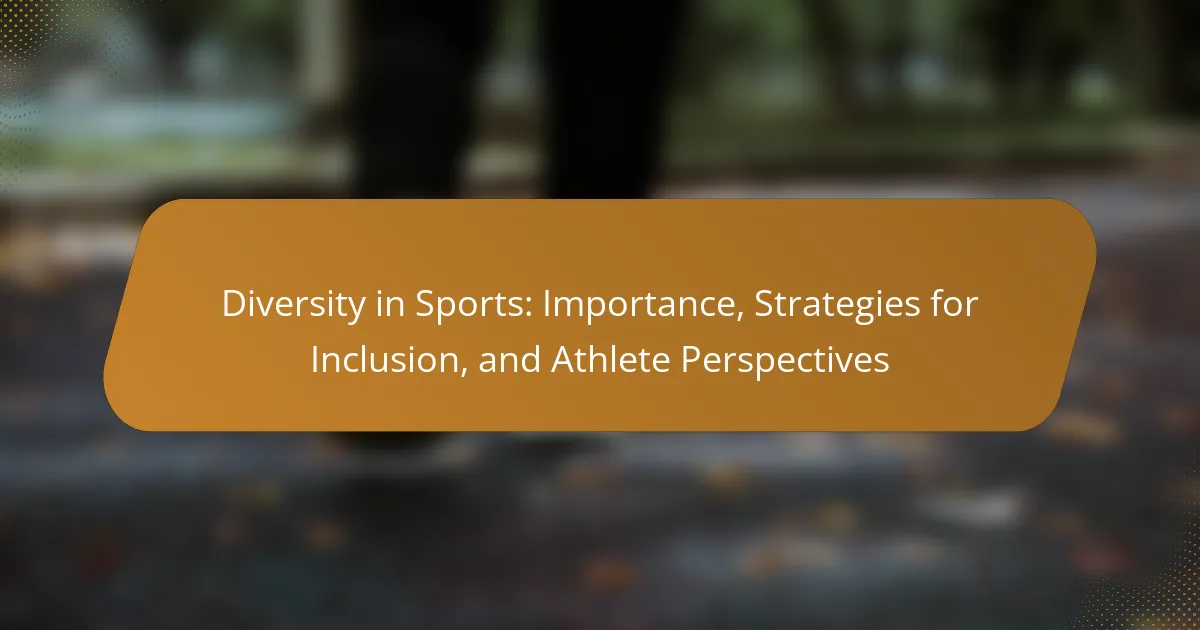Diversity in sports enhances team performance and fosters social inclusion. This article explores the importance of diversity, challenges to achieving it, strategies for inclusion, and athlete perspectives on its impact. It highlights unique initiatives and best practices to promote equitable opportunities in the sporting community.

Why is diversity important in sports?
Diversity is crucial in sports as it enhances team performance, fosters innovation, and promotes social inclusion. Diverse teams bring varied perspectives, improving problem-solving and creativity. This inclusivity also reflects society, encouraging participation from underrepresented groups. As a result, sports can drive positive change and community cohesion.
How does diversity enhance team performance?
Diversity enhances team performance by fostering creativity, improving problem-solving, and increasing adaptability. Diverse teams bring varied perspectives, which lead to innovative solutions. For example, studies show that diverse groups outperform homogenous ones in decision-making tasks by 60%. Additionally, inclusion strategies cultivate a sense of belonging, motivating athletes to perform at their best. Overall, embracing diversity in sports not only strengthens team dynamics but also boosts overall success.
What are the societal benefits of diverse representation in sports?
Diverse representation in sports fosters social cohesion and equality. It enhances community engagement, inspires underrepresented groups, and promotes role models. Research shows diverse teams perform better, driving innovation and creativity. This representation challenges stereotypes and encourages acceptance across cultures.

What challenges exist in achieving diversity in sports?
Achieving diversity in sports faces several challenges, including systemic barriers, cultural biases, and limited access to resources. These obstacles hinder participation and representation across various demographics. For instance, underfunded programs often restrict opportunities for marginalized groups. Additionally, stereotypes and discrimination can discourage athletes from diverse backgrounds. As a result, fostering an inclusive environment requires concerted efforts to address these issues and promote equity in sports.
Which barriers do underrepresented groups face in sports?
Underrepresented groups in sports face barriers such as lack of access to resources, systemic discrimination, and limited representation in leadership roles. These obstacles hinder participation and progression in athletic careers.
Access to facilities and funding remains a significant issue. Many underrepresented athletes lack the financial support needed for training and competition. Additionally, cultural biases and stereotypes can discourage participation and acceptance in various sports.
Representation is crucial for role modeling and mentorship. When underrepresented groups see athletes who share their backgrounds succeeding, it encourages their involvement. However, the scarcity of diverse leaders in sports organizations perpetuates these barriers.
Lastly, media coverage often overlooks the achievements of underrepresented athletes, impacting visibility and sponsorship opportunities. This lack of attention reinforces existing disparities and limits the growth of diversity in sports.
How do cultural perceptions impact diversity in different regions?
Cultural perceptions significantly influence diversity in sports across regions. These perceptions shape participation, representation, and acceptance of diverse athletes. For instance, in regions with strong community support for inclusivity, diverse athletes thrive and receive recognition. Conversely, in areas with traditional views, barriers to participation can limit diversity. Understanding these dynamics helps develop effective strategies for fostering inclusivity in sports.

What strategies can organizations implement for inclusion?
Organizations can implement several strategies for inclusion in sports. First, they should establish diversity training programs to raise awareness about biases. Second, creating mentorship opportunities can support underrepresented athletes. Third, inclusive policies must be developed to ensure fair recruitment and retention practices. Lastly, fostering an open dialogue within teams encourages diverse perspectives and enhances collaboration. These strategies not only promote inclusion but also improve team performance and athlete satisfaction.
How can sports organizations develop inclusive policies?
Sports organizations can develop inclusive policies by prioritizing diverse representation and fostering an environment of respect. They should assess existing practices, engage with underrepresented communities, and implement training programs focused on inclusion. Regular evaluations and adjustments to policies ensure ongoing relevance and effectiveness. Collaboration with advocacy groups enhances understanding of diverse needs and perspectives.
What role do training programs play in promoting diversity?
Training programs play a crucial role in promoting diversity by fostering inclusive environments. They equip participants with skills to recognize and challenge biases, enhancing team cohesion. Effective training increases awareness of diverse perspectives, leading to improved performance and innovation. Programs that incorporate athlete feedback can tailor strategies to address unique challenges, ensuring broader representation in sports.
Which partnerships can enhance diversity initiatives in sports?
Collaborations with community organizations, educational institutions, and corporate sponsors can enhance diversity initiatives in sports. These partnerships promote inclusive programs, increase representation, and provide resources for underrepresented athletes. Collaborating with local nonprofits can help reach diverse communities. Educational institutions can offer scholarships and mentorship programs. Corporate sponsors can fund initiatives and provide visibility. Engaging these partners fosters a supportive environment for all athletes, ultimately enriching the sports landscape.

How do athletes perceive diversity in their sports?
Athletes generally perceive diversity in sports as essential for fostering inclusivity and improving performance. Many believe that diverse teams enhance creativity and problem-solving. Research indicates that athletes from varied backgrounds contribute unique perspectives, leading to stronger team dynamics. Additionally, athletes advocate for equitable opportunities and representation, recognizing that diversity can drive positive change in sports culture.
What experiences do athletes from diverse backgrounds share?
Athletes from diverse backgrounds share experiences of overcoming challenges, building resilience, and fostering community. They often find common ground in their pursuit of excellence and the passion for their sport. Shared experiences include facing discrimination, navigating cultural differences, and leveraging unique perspectives to enhance team dynamics. These interactions promote empathy and collaboration across varied backgrounds, enriching the sports environment.
How do athletes advocate for diversity and inclusion?
Athletes advocate for diversity and inclusion by using their platforms to raise awareness and promote change. They engage in community outreach, support diverse representation in sports, and participate in campaigns that challenge discrimination. For instance, athletes like Colin Kaepernick and Megan Rapinoe have taken strong stances on social justice issues, inspiring others to join the movement. Their actions not only highlight the importance of diversity in sports but also encourage organizations to implement inclusive policies. By sharing personal stories and experiences, athletes foster a culture of acceptance and equality, ultimately benefiting the entire sports community.

What are the unique initiatives for promoting diversity in sports?
Unique initiatives for promoting diversity in sports include targeted funding programs, mentorship opportunities, and community outreach efforts. Organizations are increasingly implementing training sessions focused on inclusivity, fostering environments that welcome diverse athletes. For example, the Women’s Sports Foundation champions gender equity through grants and advocacy. As a result, participation rates among underrepresented groups are rising, enhancing overall representation in various sports. These initiatives not only support athletes but also promote cultural awareness and acceptance within the sporting community.
Which successful diversity programs exist in professional leagues?
Several successful diversity programs exist in professional leagues, focusing on inclusion and representation. The NFL’s Rooney Rule mandates interviews of minority candidates for head coaching positions. The NBA’s Basketball Without Borders program promotes diversity through global outreach and youth engagement. Major League Baseball’s Diversity Fellowship Program supports minority candidates in front-office roles. The NHL’s Hockey Is For Everyone initiative encourages participation from diverse communities. These programs demonstrate commitment to fostering inclusive environments in sports.
How do grassroots organizations contribute to diversity in sports?
Grassroots organizations significantly enhance diversity in sports by fostering inclusion and representation. They create accessible programs that engage underrepresented communities, promoting participation at all levels. These organizations often focus on local outreach, providing resources and support to marginalized groups, ensuring diverse talent is nurtured. As a result, they contribute to a broader range of perspectives and experiences in sports, enriching the overall culture and competitiveness.

What best practices can enhance diversity efforts in sports?
Implementing best practices can significantly enhance diversity efforts in sports. Organizations should prioritize inclusive recruitment, provide diversity training, and establish mentorship programs.
1. Inclusive Recruitment: Actively seek diverse candidates for all roles, from athletes to coaching staff.
2. Diversity Training: Conduct regular training sessions to raise awareness and foster an inclusive culture.
3. Mentorship Programs: Pair underrepresented athletes with experienced mentors to support their development.
4. Community Engagement: Collaborate with diverse communities to build relationships and encourage participation in sports.
5. Policy Development: Create and enforce policies that promote equity and address discrimination.
6. Performance Metrics: Track diversity metrics to assess progress and hold organizations accountable.
These strategies foster a more inclusive environment, benefiting athletes and the sports community as a whole.
How can data analytics inform diversity strategies in sports?
Data analytics can significantly enhance diversity strategies in sports by providing actionable insights. By analyzing demographic data, organizations can identify gaps in representation and tailor initiatives to promote inclusion.
For example, data can reveal participation rates among different racial and ethnic groups, enabling targeted outreach programs. Additionally, analytics can assess the effectiveness of existing diversity initiatives, allowing for adjustments based on performance metrics.
Athlete feedback collected through surveys can also be analyzed to understand their experiences and perceptions regarding diversity. This information can guide policy changes and foster a more inclusive environment.
Overall, leveraging data analytics equips sports organizations to make informed decisions that advance diversity and inclusion effectively.
What common mistakes should organizations avoid in diversity initiatives?
Organizations should avoid common mistakes in diversity initiatives to ensure effectiveness. Key pitfalls include lack of clear goals, superficial engagement, inadequate training, and failure to measure progress.
1. Lack of clear goals: Without specific objectives, initiatives may lack direction and accountability.
2. Superficial engagement: Focusing on tokenism rather than genuine inclusion can alienate marginalized groups.
3. Inadequate training: Insufficient education on diversity issues can hinder understanding and commitment among staff.
4. Failure to measure progress: Not tracking outcomes can prevent organizations from identifying areas for improvement.
Which expert tips can guide effective diversity implementation in sports?
Expert tips for effective diversity implementation in sports include fostering an inclusive culture, providing diversity training, and promoting diverse leadership. Engaging athletes in discussions about their experiences can enhance understanding and commitment. Establishing clear goals and metrics for diversity initiatives ensures accountability and progress. Collaborating with community organizations can broaden outreach and support diverse participation.
